Essay: Significant Determinates of Health in Context to Obesity in UK
VerifiedAdded on 2020/10/04
|11
|3919
|115
Essay
AI Summary
This essay critically examines the significant determinants of health in the context of obesity, focusing on the UK's situation. It highlights the increasing prevalence of obesity, emphasizing its impact on health outcomes and mortality rates. The essay delves into the causes of obesity, including diet, lifestyle, and education, while also exploring genetic influences and environmental factors. It discusses the various diseases and conditions associated with obesity, such as cardiovascular diseases, diabetes, and certain cancers, and analyzes the effects on both individual health and the healthcare system. The essay underscores the importance of understanding obesity's complex interplay of factors to develop effective strategies for prevention and intervention, advocating for government initiatives to address the issue and promote healthier lifestyles within the UK population. The essay also includes the effects of obesity on morbidity and mortality.

ESSAY
Paraphrase This Document
Need a fresh take? Get an instant paraphrase of this document with our AI Paraphraser

Table of Contents
INTRODUCTION...........................................................................................................................1
CONCLUSION................................................................................................................................7
REFERENCES ...............................................................................................................................8
INTRODUCTION...........................................................................................................................1
CONCLUSION................................................................................................................................7
REFERENCES ...............................................................................................................................8
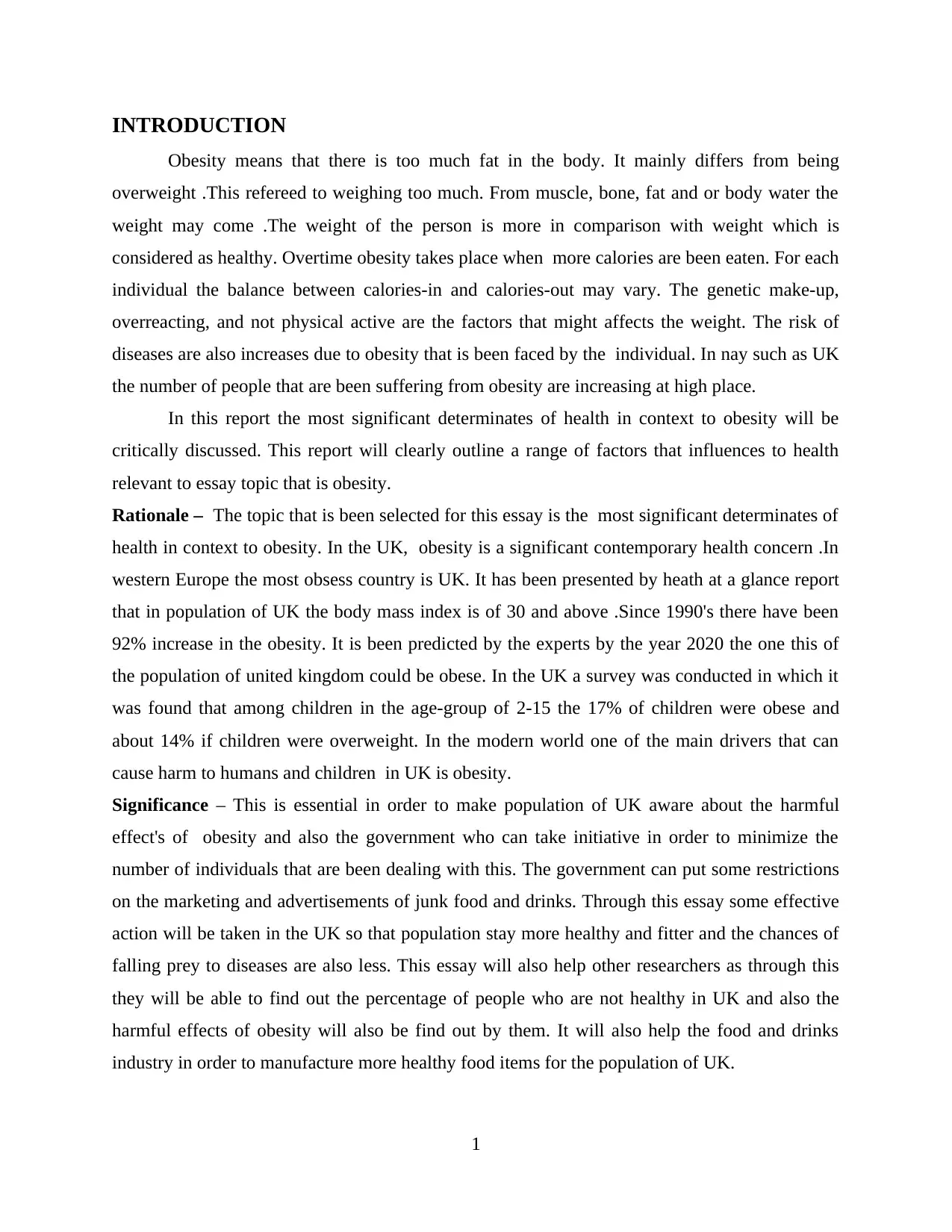
INTRODUCTION
Obesity means that there is too much fat in the body. It mainly differs from being
overweight .This refereed to weighing too much. From muscle, bone, fat and or body water the
weight may come .The weight of the person is more in comparison with weight which is
considered as healthy. Overtime obesity takes place when more calories are been eaten. For each
individual the balance between calories-in and calories-out may vary. The genetic make-up,
overreacting, and not physical active are the factors that might affects the weight. The risk of
diseases are also increases due to obesity that is been faced by the individual. In nay such as UK
the number of people that are been suffering from obesity are increasing at high place.
In this report the most significant determinates of health in context to obesity will be
critically discussed. This report will clearly outline a range of factors that influences to health
relevant to essay topic that is obesity.
Rationale – The topic that is been selected for this essay is the most significant determinates of
health in context to obesity. In the UK, obesity is a significant contemporary health concern .In
western Europe the most obsess country is UK. It has been presented by heath at a glance report
that in population of UK the body mass index is of 30 and above .Since 1990's there have been
92% increase in the obesity. It is been predicted by the experts by the year 2020 the one this of
the population of united kingdom could be obese. In the UK a survey was conducted in which it
was found that among children in the age-group of 2-15 the 17% of children were obese and
about 14% if children were overweight. In the modern world one of the main drivers that can
cause harm to humans and children in UK is obesity.
Significance – This is essential in order to make population of UK aware about the harmful
effect's of obesity and also the government who can take initiative in order to minimize the
number of individuals that are been dealing with this. The government can put some restrictions
on the marketing and advertisements of junk food and drinks. Through this essay some effective
action will be taken in the UK so that population stay more healthy and fitter and the chances of
falling prey to diseases are also less. This essay will also help other researchers as through this
they will be able to find out the percentage of people who are not healthy in UK and also the
harmful effects of obesity will also be find out by them. It will also help the food and drinks
industry in order to manufacture more healthy food items for the population of UK.
1
Obesity means that there is too much fat in the body. It mainly differs from being
overweight .This refereed to weighing too much. From muscle, bone, fat and or body water the
weight may come .The weight of the person is more in comparison with weight which is
considered as healthy. Overtime obesity takes place when more calories are been eaten. For each
individual the balance between calories-in and calories-out may vary. The genetic make-up,
overreacting, and not physical active are the factors that might affects the weight. The risk of
diseases are also increases due to obesity that is been faced by the individual. In nay such as UK
the number of people that are been suffering from obesity are increasing at high place.
In this report the most significant determinates of health in context to obesity will be
critically discussed. This report will clearly outline a range of factors that influences to health
relevant to essay topic that is obesity.
Rationale – The topic that is been selected for this essay is the most significant determinates of
health in context to obesity. In the UK, obesity is a significant contemporary health concern .In
western Europe the most obsess country is UK. It has been presented by heath at a glance report
that in population of UK the body mass index is of 30 and above .Since 1990's there have been
92% increase in the obesity. It is been predicted by the experts by the year 2020 the one this of
the population of united kingdom could be obese. In the UK a survey was conducted in which it
was found that among children in the age-group of 2-15 the 17% of children were obese and
about 14% if children were overweight. In the modern world one of the main drivers that can
cause harm to humans and children in UK is obesity.
Significance – This is essential in order to make population of UK aware about the harmful
effect's of obesity and also the government who can take initiative in order to minimize the
number of individuals that are been dealing with this. The government can put some restrictions
on the marketing and advertisements of junk food and drinks. Through this essay some effective
action will be taken in the UK so that population stay more healthy and fitter and the chances of
falling prey to diseases are also less. This essay will also help other researchers as through this
they will be able to find out the percentage of people who are not healthy in UK and also the
harmful effects of obesity will also be find out by them. It will also help the food and drinks
industry in order to manufacture more healthy food items for the population of UK.
1
⊘ This is a preview!⊘
Do you want full access?
Subscribe today to unlock all pages.

Trusted by 1+ million students worldwide
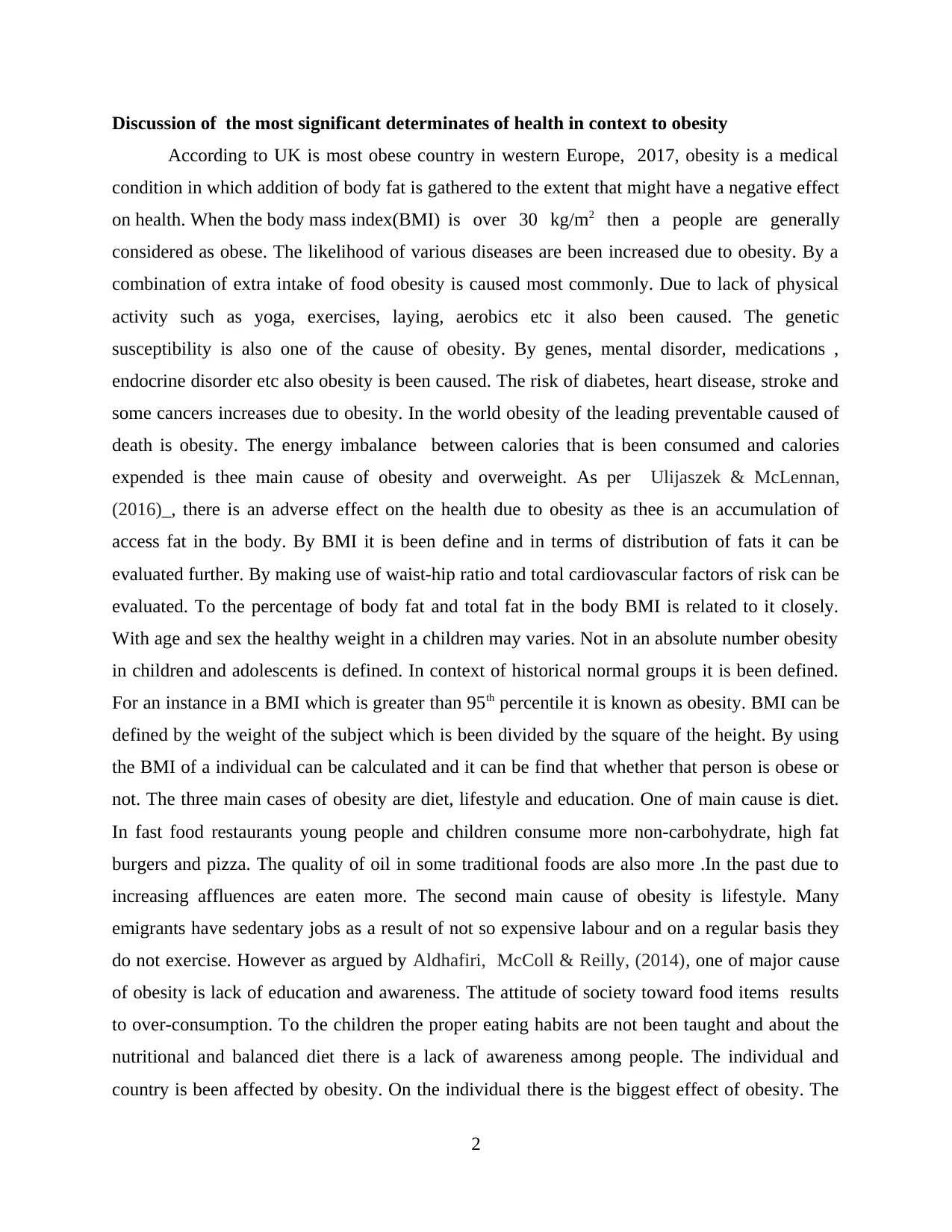
Discussion of the most significant determinates of health in context to obesity
According to UK is most obese country in western Europe, 2017, obesity is a medical
condition in which addition of body fat is gathered to the extent that might have a negative effect
on health. When the body mass index(BMI) is over 30 kg/m2 then a people are generally
considered as obese. The likelihood of various diseases are been increased due to obesity. By a
combination of extra intake of food obesity is caused most commonly. Due to lack of physical
activity such as yoga, exercises, laying, aerobics etc it also been caused. The genetic
susceptibility is also one of the cause of obesity. By genes, mental disorder, medications ,
endocrine disorder etc also obesity is been caused. The risk of diabetes, heart disease, stroke and
some cancers increases due to obesity. In the world obesity of the leading preventable caused of
death is obesity. The energy imbalance between calories that is been consumed and calories
expended is thee main cause of obesity and overweight. As per Ulijaszek & McLennan,
(2016)_, there is an adverse effect on the health due to obesity as thee is an accumulation of
access fat in the body. By BMI it is been define and in terms of distribution of fats it can be
evaluated further. By making use of waist-hip ratio and total cardiovascular factors of risk can be
evaluated. To the percentage of body fat and total fat in the body BMI is related to it closely.
With age and sex the healthy weight in a children may varies. Not in an absolute number obesity
in children and adolescents is defined. In context of historical normal groups it is been defined.
For an instance in a BMI which is greater than 95th percentile it is known as obesity. BMI can be
defined by the weight of the subject which is been divided by the square of the height. By using
the BMI of a individual can be calculated and it can be find that whether that person is obese or
not. The three main cases of obesity are diet, lifestyle and education. One of main cause is diet.
In fast food restaurants young people and children consume more non-carbohydrate, high fat
burgers and pizza. The quality of oil in some traditional foods are also more .In the past due to
increasing affluences are eaten more. The second main cause of obesity is lifestyle. Many
emigrants have sedentary jobs as a result of not so expensive labour and on a regular basis they
do not exercise. However as argued by Aldhafiri, McColl & Reilly, (2014), one of major cause
of obesity is lack of education and awareness. The attitude of society toward food items results
to over-consumption. To the children the proper eating habits are not been taught and about the
nutritional and balanced diet there is a lack of awareness among people. The individual and
country is been affected by obesity. On the individual there is the biggest effect of obesity. The
2
According to UK is most obese country in western Europe, 2017, obesity is a medical
condition in which addition of body fat is gathered to the extent that might have a negative effect
on health. When the body mass index(BMI) is over 30 kg/m2 then a people are generally
considered as obese. The likelihood of various diseases are been increased due to obesity. By a
combination of extra intake of food obesity is caused most commonly. Due to lack of physical
activity such as yoga, exercises, laying, aerobics etc it also been caused. The genetic
susceptibility is also one of the cause of obesity. By genes, mental disorder, medications ,
endocrine disorder etc also obesity is been caused. The risk of diabetes, heart disease, stroke and
some cancers increases due to obesity. In the world obesity of the leading preventable caused of
death is obesity. The energy imbalance between calories that is been consumed and calories
expended is thee main cause of obesity and overweight. As per Ulijaszek & McLennan,
(2016)_, there is an adverse effect on the health due to obesity as thee is an accumulation of
access fat in the body. By BMI it is been define and in terms of distribution of fats it can be
evaluated further. By making use of waist-hip ratio and total cardiovascular factors of risk can be
evaluated. To the percentage of body fat and total fat in the body BMI is related to it closely.
With age and sex the healthy weight in a children may varies. Not in an absolute number obesity
in children and adolescents is defined. In context of historical normal groups it is been defined.
For an instance in a BMI which is greater than 95th percentile it is known as obesity. BMI can be
defined by the weight of the subject which is been divided by the square of the height. By using
the BMI of a individual can be calculated and it can be find that whether that person is obese or
not. The three main cases of obesity are diet, lifestyle and education. One of main cause is diet.
In fast food restaurants young people and children consume more non-carbohydrate, high fat
burgers and pizza. The quality of oil in some traditional foods are also more .In the past due to
increasing affluences are eaten more. The second main cause of obesity is lifestyle. Many
emigrants have sedentary jobs as a result of not so expensive labour and on a regular basis they
do not exercise. However as argued by Aldhafiri, McColl & Reilly, (2014), one of major cause
of obesity is lack of education and awareness. The attitude of society toward food items results
to over-consumption. To the children the proper eating habits are not been taught and about the
nutritional and balanced diet there is a lack of awareness among people. The individual and
country is been affected by obesity. On the individual there is the biggest effect of obesity. The
2
Paraphrase This Document
Need a fresh take? Get an instant paraphrase of this document with our AI Paraphraser
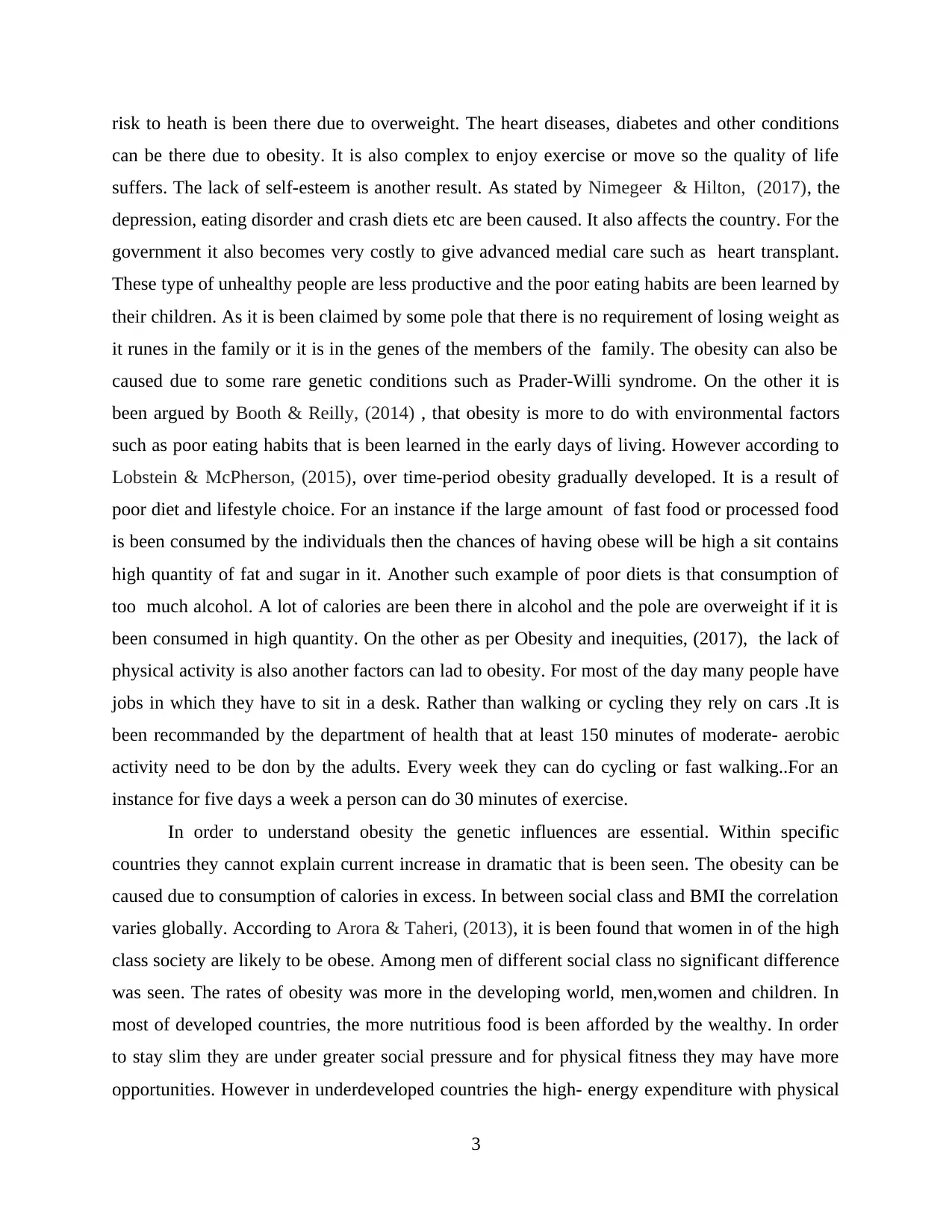
risk to heath is been there due to overweight. The heart diseases, diabetes and other conditions
can be there due to obesity. It is also complex to enjoy exercise or move so the quality of life
suffers. The lack of self-esteem is another result. As stated by Nimegeer & Hilton, (2017), the
depression, eating disorder and crash diets etc are been caused. It also affects the country. For the
government it also becomes very costly to give advanced medial care such as heart transplant.
These type of unhealthy people are less productive and the poor eating habits are been learned by
their children. As it is been claimed by some pole that there is no requirement of losing weight as
it runes in the family or it is in the genes of the members of the family. The obesity can also be
caused due to some rare genetic conditions such as Prader-Willi syndrome. On the other it is
been argued by Booth & Reilly, (2014) , that obesity is more to do with environmental factors
such as poor eating habits that is been learned in the early days of living. However according to
Lobstein & McPherson, (2015), over time-period obesity gradually developed. It is a result of
poor diet and lifestyle choice. For an instance if the large amount of fast food or processed food
is been consumed by the individuals then the chances of having obese will be high a sit contains
high quantity of fat and sugar in it. Another such example of poor diets is that consumption of
too much alcohol. A lot of calories are been there in alcohol and the pole are overweight if it is
been consumed in high quantity. On the other as per Obesity and inequities, (2017), the lack of
physical activity is also another factors can lad to obesity. For most of the day many people have
jobs in which they have to sit in a desk. Rather than walking or cycling they rely on cars .It is
been recommanded by the department of health that at least 150 minutes of moderate- aerobic
activity need to be don by the adults. Every week they can do cycling or fast walking..For an
instance for five days a week a person can do 30 minutes of exercise.
In order to understand obesity the genetic influences are essential. Within specific
countries they cannot explain current increase in dramatic that is been seen. The obesity can be
caused due to consumption of calories in excess. In between social class and BMI the correlation
varies globally. According to Arora & Taheri, (2013), it is been found that women in of the high
class society are likely to be obese. Among men of different social class no significant difference
was seen. The rates of obesity was more in the developing world, men,women and children. In
most of developed countries, the more nutritious food is been afforded by the wealthy. In order
to stay slim they are under greater social pressure and for physical fitness they may have more
opportunities. However in underdeveloped countries the high- energy expenditure with physical
3
can be there due to obesity. It is also complex to enjoy exercise or move so the quality of life
suffers. The lack of self-esteem is another result. As stated by Nimegeer & Hilton, (2017), the
depression, eating disorder and crash diets etc are been caused. It also affects the country. For the
government it also becomes very costly to give advanced medial care such as heart transplant.
These type of unhealthy people are less productive and the poor eating habits are been learned by
their children. As it is been claimed by some pole that there is no requirement of losing weight as
it runes in the family or it is in the genes of the members of the family. The obesity can also be
caused due to some rare genetic conditions such as Prader-Willi syndrome. On the other it is
been argued by Booth & Reilly, (2014) , that obesity is more to do with environmental factors
such as poor eating habits that is been learned in the early days of living. However according to
Lobstein & McPherson, (2015), over time-period obesity gradually developed. It is a result of
poor diet and lifestyle choice. For an instance if the large amount of fast food or processed food
is been consumed by the individuals then the chances of having obese will be high a sit contains
high quantity of fat and sugar in it. Another such example of poor diets is that consumption of
too much alcohol. A lot of calories are been there in alcohol and the pole are overweight if it is
been consumed in high quantity. On the other as per Obesity and inequities, (2017), the lack of
physical activity is also another factors can lad to obesity. For most of the day many people have
jobs in which they have to sit in a desk. Rather than walking or cycling they rely on cars .It is
been recommanded by the department of health that at least 150 minutes of moderate- aerobic
activity need to be don by the adults. Every week they can do cycling or fast walking..For an
instance for five days a week a person can do 30 minutes of exercise.
In order to understand obesity the genetic influences are essential. Within specific
countries they cannot explain current increase in dramatic that is been seen. The obesity can be
caused due to consumption of calories in excess. In between social class and BMI the correlation
varies globally. According to Arora & Taheri, (2013), it is been found that women in of the high
class society are likely to be obese. Among men of different social class no significant difference
was seen. The rates of obesity was more in the developing world, men,women and children. In
most of developed countries, the more nutritious food is been afforded by the wealthy. In order
to stay slim they are under greater social pressure and for physical fitness they may have more
opportunities. However in underdeveloped countries the high- energy expenditure with physical
3
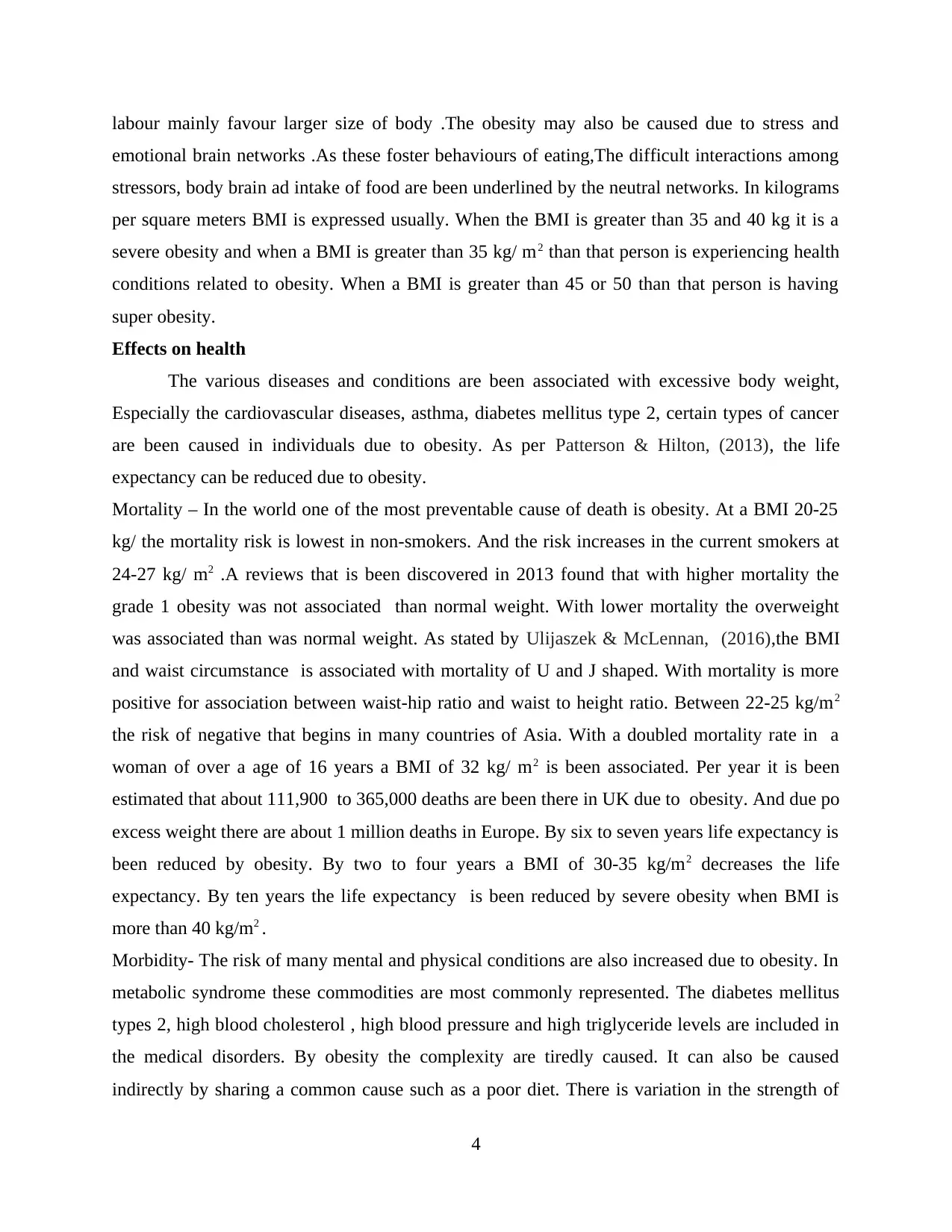
labour mainly favour larger size of body .The obesity may also be caused due to stress and
emotional brain networks .As these foster behaviours of eating,The difficult interactions among
stressors, body brain ad intake of food are been underlined by the neutral networks. In kilograms
per square meters BMI is expressed usually. When the BMI is greater than 35 and 40 kg it is a
severe obesity and when a BMI is greater than 35 kg/ m2 than that person is experiencing health
conditions related to obesity. When a BMI is greater than 45 or 50 than that person is having
super obesity.
Effects on health
The various diseases and conditions are been associated with excessive body weight,
Especially the cardiovascular diseases, asthma, diabetes mellitus type 2, certain types of cancer
are been caused in individuals due to obesity. As per Patterson & Hilton, (2013), the life
expectancy can be reduced due to obesity.
Mortality – In the world one of the most preventable cause of death is obesity. At a BMI 20-25
kg/ the mortality risk is lowest in non-smokers. And the risk increases in the current smokers at
24-27 kg/ m2 .A reviews that is been discovered in 2013 found that with higher mortality the
grade 1 obesity was not associated than normal weight. With lower mortality the overweight
was associated than was normal weight. As stated by Ulijaszek & McLennan, (2016),the BMI
and waist circumstance is associated with mortality of U and J shaped. With mortality is more
positive for association between waist-hip ratio and waist to height ratio. Between 22-25 kg/m2
the risk of negative that begins in many countries of Asia. With a doubled mortality rate in a
woman of over a age of 16 years a BMI of 32 kg/ m2 is been associated. Per year it is been
estimated that about 111,900 to 365,000 deaths are been there in UK due to obesity. And due po
excess weight there are about 1 million deaths in Europe. By six to seven years life expectancy is
been reduced by obesity. By two to four years a BMI of 30-35 kg/m2 decreases the life
expectancy. By ten years the life expectancy is been reduced by severe obesity when BMI is
more than 40 kg/m2 .
Morbidity- The risk of many mental and physical conditions are also increased due to obesity. In
metabolic syndrome these commodities are most commonly represented. The diabetes mellitus
types 2, high blood cholesterol , high blood pressure and high triglyceride levels are included in
the medical disorders. By obesity the complexity are tiredly caused. It can also be caused
indirectly by sharing a common cause such as a poor diet. There is variation in the strength of
4
emotional brain networks .As these foster behaviours of eating,The difficult interactions among
stressors, body brain ad intake of food are been underlined by the neutral networks. In kilograms
per square meters BMI is expressed usually. When the BMI is greater than 35 and 40 kg it is a
severe obesity and when a BMI is greater than 35 kg/ m2 than that person is experiencing health
conditions related to obesity. When a BMI is greater than 45 or 50 than that person is having
super obesity.
Effects on health
The various diseases and conditions are been associated with excessive body weight,
Especially the cardiovascular diseases, asthma, diabetes mellitus type 2, certain types of cancer
are been caused in individuals due to obesity. As per Patterson & Hilton, (2013), the life
expectancy can be reduced due to obesity.
Mortality – In the world one of the most preventable cause of death is obesity. At a BMI 20-25
kg/ the mortality risk is lowest in non-smokers. And the risk increases in the current smokers at
24-27 kg/ m2 .A reviews that is been discovered in 2013 found that with higher mortality the
grade 1 obesity was not associated than normal weight. With lower mortality the overweight
was associated than was normal weight. As stated by Ulijaszek & McLennan, (2016),the BMI
and waist circumstance is associated with mortality of U and J shaped. With mortality is more
positive for association between waist-hip ratio and waist to height ratio. Between 22-25 kg/m2
the risk of negative that begins in many countries of Asia. With a doubled mortality rate in a
woman of over a age of 16 years a BMI of 32 kg/ m2 is been associated. Per year it is been
estimated that about 111,900 to 365,000 deaths are been there in UK due to obesity. And due po
excess weight there are about 1 million deaths in Europe. By six to seven years life expectancy is
been reduced by obesity. By two to four years a BMI of 30-35 kg/m2 decreases the life
expectancy. By ten years the life expectancy is been reduced by severe obesity when BMI is
more than 40 kg/m2 .
Morbidity- The risk of many mental and physical conditions are also increased due to obesity. In
metabolic syndrome these commodities are most commonly represented. The diabetes mellitus
types 2, high blood cholesterol , high blood pressure and high triglyceride levels are included in
the medical disorders. By obesity the complexity are tiredly caused. It can also be caused
indirectly by sharing a common cause such as a poor diet. There is variation in the strength of
4
⊘ This is a preview!⊘
Do you want full access?
Subscribe today to unlock all pages.

Trusted by 1+ million students worldwide
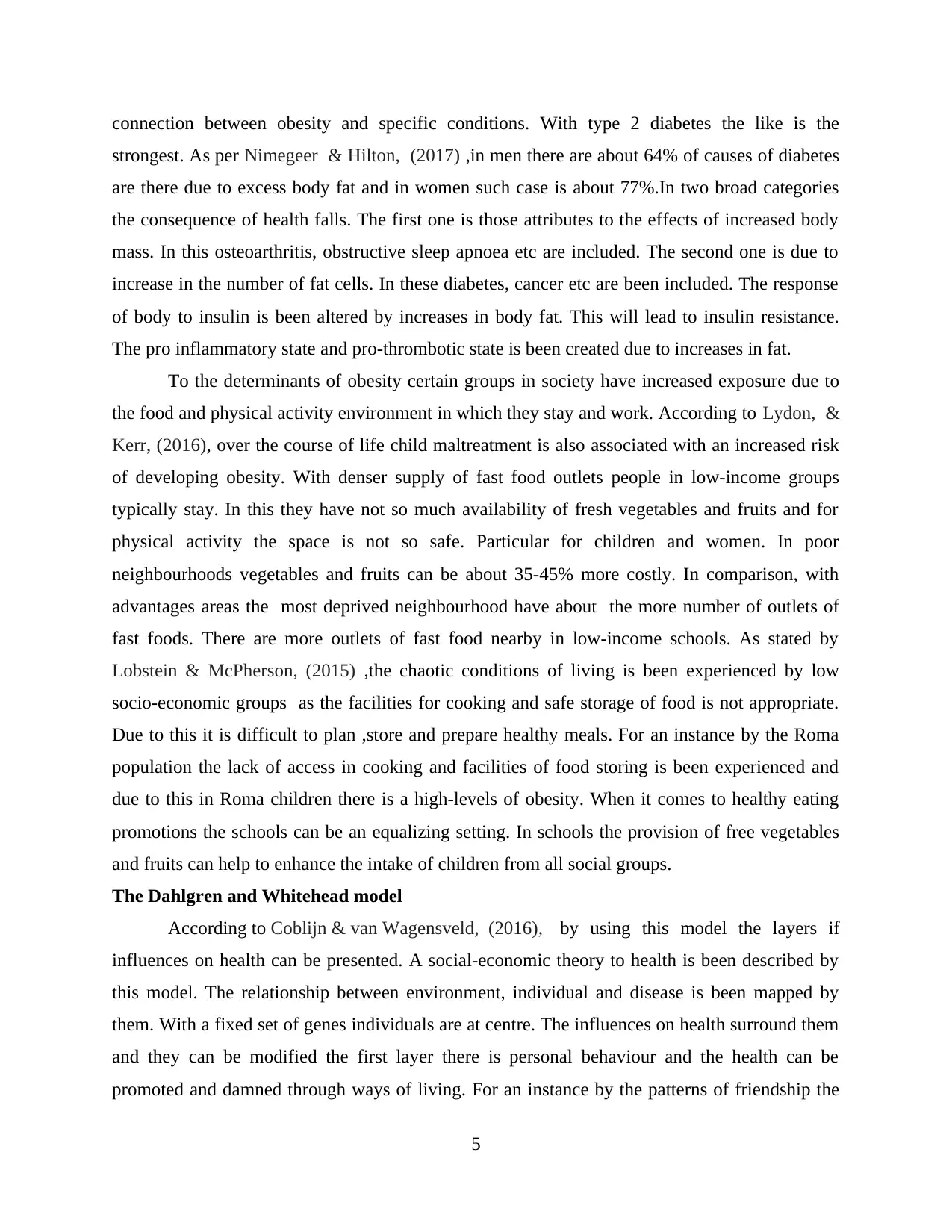
connection between obesity and specific conditions. With type 2 diabetes the like is the
strongest. As per Nimegeer & Hilton, (2017) ,in men there are about 64% of causes of diabetes
are there due to excess body fat and in women such case is about 77%.In two broad categories
the consequence of health falls. The first one is those attributes to the effects of increased body
mass. In this osteoarthritis, obstructive sleep apnoea etc are included. The second one is due to
increase in the number of fat cells. In these diabetes, cancer etc are been included. The response
of body to insulin is been altered by increases in body fat. This will lead to insulin resistance.
The pro inflammatory state and pro-thrombotic state is been created due to increases in fat.
To the determinants of obesity certain groups in society have increased exposure due to
the food and physical activity environment in which they stay and work. According to Lydon, &
Kerr, (2016), over the course of life child maltreatment is also associated with an increased risk
of developing obesity. With denser supply of fast food outlets people in low-income groups
typically stay. In this they have not so much availability of fresh vegetables and fruits and for
physical activity the space is not so safe. Particular for children and women. In poor
neighbourhoods vegetables and fruits can be about 35-45% more costly. In comparison, with
advantages areas the most deprived neighbourhood have about the more number of outlets of
fast foods. There are more outlets of fast food nearby in low-income schools. As stated by
Lobstein & McPherson, (2015) ,the chaotic conditions of living is been experienced by low
socio-economic groups as the facilities for cooking and safe storage of food is not appropriate.
Due to this it is difficult to plan ,store and prepare healthy meals. For an instance by the Roma
population the lack of access in cooking and facilities of food storing is been experienced and
due to this in Roma children there is a high-levels of obesity. When it comes to healthy eating
promotions the schools can be an equalizing setting. In schools the provision of free vegetables
and fruits can help to enhance the intake of children from all social groups.
The Dahlgren and Whitehead model
According to Coblijn & van Wagensveld, (2016), by using this model the layers if
influences on health can be presented. A social-economic theory to health is been described by
this model. The relationship between environment, individual and disease is been mapped by
them. With a fixed set of genes individuals are at centre. The influences on health surround them
and they can be modified the first layer there is personal behaviour and the health can be
promoted and damned through ways of living. For an instance by the patterns of friendship the
5
strongest. As per Nimegeer & Hilton, (2017) ,in men there are about 64% of causes of diabetes
are there due to excess body fat and in women such case is about 77%.In two broad categories
the consequence of health falls. The first one is those attributes to the effects of increased body
mass. In this osteoarthritis, obstructive sleep apnoea etc are included. The second one is due to
increase in the number of fat cells. In these diabetes, cancer etc are been included. The response
of body to insulin is been altered by increases in body fat. This will lead to insulin resistance.
The pro inflammatory state and pro-thrombotic state is been created due to increases in fat.
To the determinants of obesity certain groups in society have increased exposure due to
the food and physical activity environment in which they stay and work. According to Lydon, &
Kerr, (2016), over the course of life child maltreatment is also associated with an increased risk
of developing obesity. With denser supply of fast food outlets people in low-income groups
typically stay. In this they have not so much availability of fresh vegetables and fruits and for
physical activity the space is not so safe. Particular for children and women. In poor
neighbourhoods vegetables and fruits can be about 35-45% more costly. In comparison, with
advantages areas the most deprived neighbourhood have about the more number of outlets of
fast foods. There are more outlets of fast food nearby in low-income schools. As stated by
Lobstein & McPherson, (2015) ,the chaotic conditions of living is been experienced by low
socio-economic groups as the facilities for cooking and safe storage of food is not appropriate.
Due to this it is difficult to plan ,store and prepare healthy meals. For an instance by the Roma
population the lack of access in cooking and facilities of food storing is been experienced and
due to this in Roma children there is a high-levels of obesity. When it comes to healthy eating
promotions the schools can be an equalizing setting. In schools the provision of free vegetables
and fruits can help to enhance the intake of children from all social groups.
The Dahlgren and Whitehead model
According to Coblijn & van Wagensveld, (2016), by using this model the layers if
influences on health can be presented. A social-economic theory to health is been described by
this model. The relationship between environment, individual and disease is been mapped by
them. With a fixed set of genes individuals are at centre. The influences on health surround them
and they can be modified the first layer there is personal behaviour and the health can be
promoted and damned through ways of living. For an instance by the patterns of friendship the
5
Paraphrase This Document
Need a fresh take? Get an instant paraphrase of this document with our AI Paraphraser
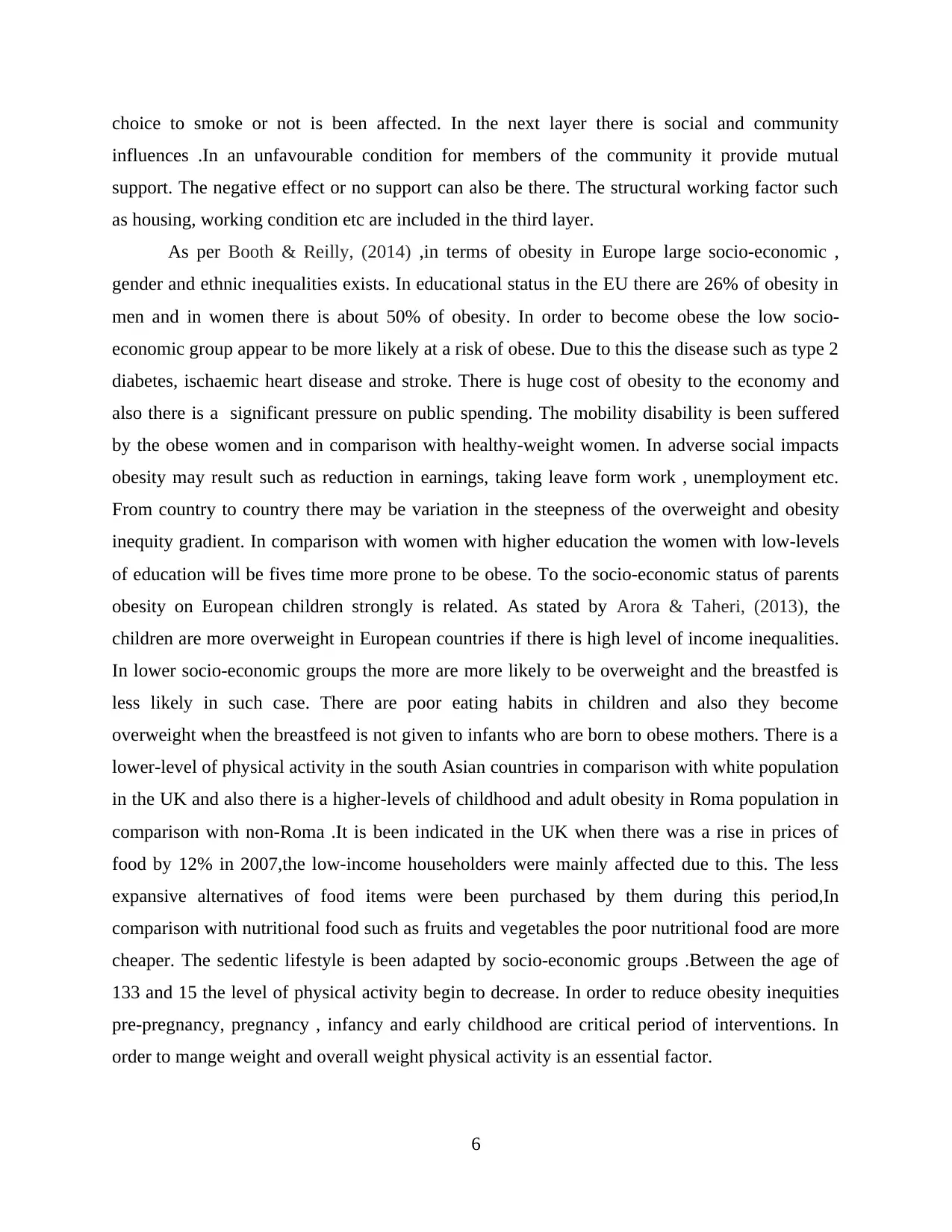
choice to smoke or not is been affected. In the next layer there is social and community
influences .In an unfavourable condition for members of the community it provide mutual
support. The negative effect or no support can also be there. The structural working factor such
as housing, working condition etc are included in the third layer.
As per Booth & Reilly, (2014) ,in terms of obesity in Europe large socio-economic ,
gender and ethnic inequalities exists. In educational status in the EU there are 26% of obesity in
men and in women there is about 50% of obesity. In order to become obese the low socio-
economic group appear to be more likely at a risk of obese. Due to this the disease such as type 2
diabetes, ischaemic heart disease and stroke. There is huge cost of obesity to the economy and
also there is a significant pressure on public spending. The mobility disability is been suffered
by the obese women and in comparison with healthy-weight women. In adverse social impacts
obesity may result such as reduction in earnings, taking leave form work , unemployment etc.
From country to country there may be variation in the steepness of the overweight and obesity
inequity gradient. In comparison with women with higher education the women with low-levels
of education will be fives time more prone to be obese. To the socio-economic status of parents
obesity on European children strongly is related. As stated by Arora & Taheri, (2013), the
children are more overweight in European countries if there is high level of income inequalities.
In lower socio-economic groups the more are more likely to be overweight and the breastfed is
less likely in such case. There are poor eating habits in children and also they become
overweight when the breastfeed is not given to infants who are born to obese mothers. There is a
lower-level of physical activity in the south Asian countries in comparison with white population
in the UK and also there is a higher-levels of childhood and adult obesity in Roma population in
comparison with non-Roma .It is been indicated in the UK when there was a rise in prices of
food by 12% in 2007,the low-income householders were mainly affected due to this. The less
expansive alternatives of food items were been purchased by them during this period,In
comparison with nutritional food such as fruits and vegetables the poor nutritional food are more
cheaper. The sedentic lifestyle is been adapted by socio-economic groups .Between the age of
133 and 15 the level of physical activity begin to decrease. In order to reduce obesity inequities
pre-pregnancy, pregnancy , infancy and early childhood are critical period of interventions. In
order to mange weight and overall weight physical activity is an essential factor.
6
influences .In an unfavourable condition for members of the community it provide mutual
support. The negative effect or no support can also be there. The structural working factor such
as housing, working condition etc are included in the third layer.
As per Booth & Reilly, (2014) ,in terms of obesity in Europe large socio-economic ,
gender and ethnic inequalities exists. In educational status in the EU there are 26% of obesity in
men and in women there is about 50% of obesity. In order to become obese the low socio-
economic group appear to be more likely at a risk of obese. Due to this the disease such as type 2
diabetes, ischaemic heart disease and stroke. There is huge cost of obesity to the economy and
also there is a significant pressure on public spending. The mobility disability is been suffered
by the obese women and in comparison with healthy-weight women. In adverse social impacts
obesity may result such as reduction in earnings, taking leave form work , unemployment etc.
From country to country there may be variation in the steepness of the overweight and obesity
inequity gradient. In comparison with women with higher education the women with low-levels
of education will be fives time more prone to be obese. To the socio-economic status of parents
obesity on European children strongly is related. As stated by Arora & Taheri, (2013), the
children are more overweight in European countries if there is high level of income inequalities.
In lower socio-economic groups the more are more likely to be overweight and the breastfed is
less likely in such case. There are poor eating habits in children and also they become
overweight when the breastfeed is not given to infants who are born to obese mothers. There is a
lower-level of physical activity in the south Asian countries in comparison with white population
in the UK and also there is a higher-levels of childhood and adult obesity in Roma population in
comparison with non-Roma .It is been indicated in the UK when there was a rise in prices of
food by 12% in 2007,the low-income householders were mainly affected due to this. The less
expansive alternatives of food items were been purchased by them during this period,In
comparison with nutritional food such as fruits and vegetables the poor nutritional food are more
cheaper. The sedentic lifestyle is been adapted by socio-economic groups .Between the age of
133 and 15 the level of physical activity begin to decrease. In order to reduce obesity inequities
pre-pregnancy, pregnancy , infancy and early childhood are critical period of interventions. In
order to mange weight and overall weight physical activity is an essential factor.
6
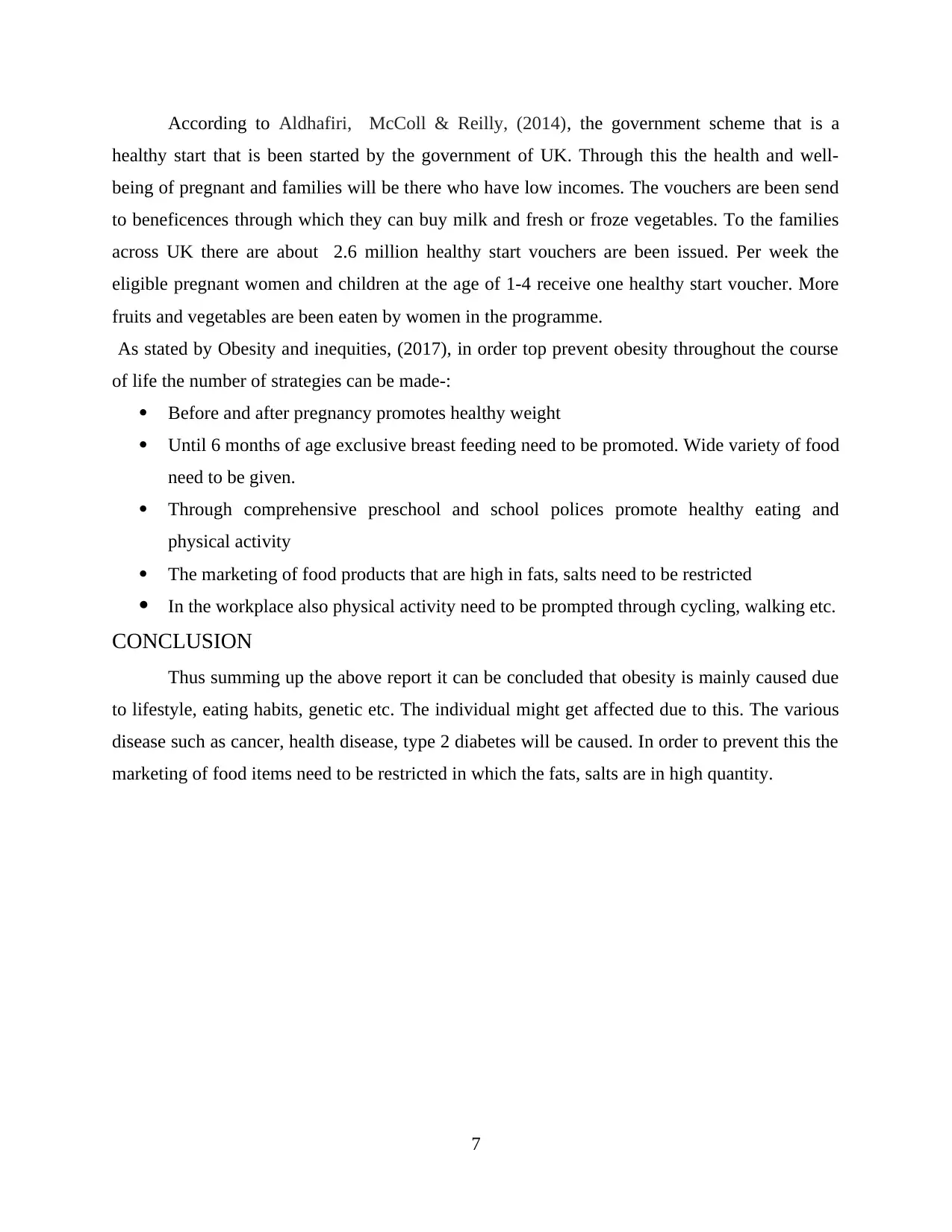
According to Aldhafiri, McColl & Reilly, (2014), the government scheme that is a
healthy start that is been started by the government of UK. Through this the health and well-
being of pregnant and families will be there who have low incomes. The vouchers are been send
to beneficences through which they can buy milk and fresh or froze vegetables. To the families
across UK there are about 2.6 million healthy start vouchers are been issued. Per week the
eligible pregnant women and children at the age of 1-4 receive one healthy start voucher. More
fruits and vegetables are been eaten by women in the programme.
As stated by Obesity and inequities, (2017), in order top prevent obesity throughout the course
of life the number of strategies can be made-:
Before and after pregnancy promotes healthy weight
Until 6 months of age exclusive breast feeding need to be promoted. Wide variety of food
need to be given.
Through comprehensive preschool and school polices promote healthy eating and
physical activity
The marketing of food products that are high in fats, salts need to be restricted
In the workplace also physical activity need to be prompted through cycling, walking etc.
CONCLUSION
Thus summing up the above report it can be concluded that obesity is mainly caused due
to lifestyle, eating habits, genetic etc. The individual might get affected due to this. The various
disease such as cancer, health disease, type 2 diabetes will be caused. In order to prevent this the
marketing of food items need to be restricted in which the fats, salts are in high quantity.
7
healthy start that is been started by the government of UK. Through this the health and well-
being of pregnant and families will be there who have low incomes. The vouchers are been send
to beneficences through which they can buy milk and fresh or froze vegetables. To the families
across UK there are about 2.6 million healthy start vouchers are been issued. Per week the
eligible pregnant women and children at the age of 1-4 receive one healthy start voucher. More
fruits and vegetables are been eaten by women in the programme.
As stated by Obesity and inequities, (2017), in order top prevent obesity throughout the course
of life the number of strategies can be made-:
Before and after pregnancy promotes healthy weight
Until 6 months of age exclusive breast feeding need to be promoted. Wide variety of food
need to be given.
Through comprehensive preschool and school polices promote healthy eating and
physical activity
The marketing of food products that are high in fats, salts need to be restricted
In the workplace also physical activity need to be prompted through cycling, walking etc.
CONCLUSION
Thus summing up the above report it can be concluded that obesity is mainly caused due
to lifestyle, eating habits, genetic etc. The individual might get affected due to this. The various
disease such as cancer, health disease, type 2 diabetes will be caused. In order to prevent this the
marketing of food items need to be restricted in which the fats, salts are in high quantity.
7
⊘ This is a preview!⊘
Do you want full access?
Subscribe today to unlock all pages.

Trusted by 1+ million students worldwide
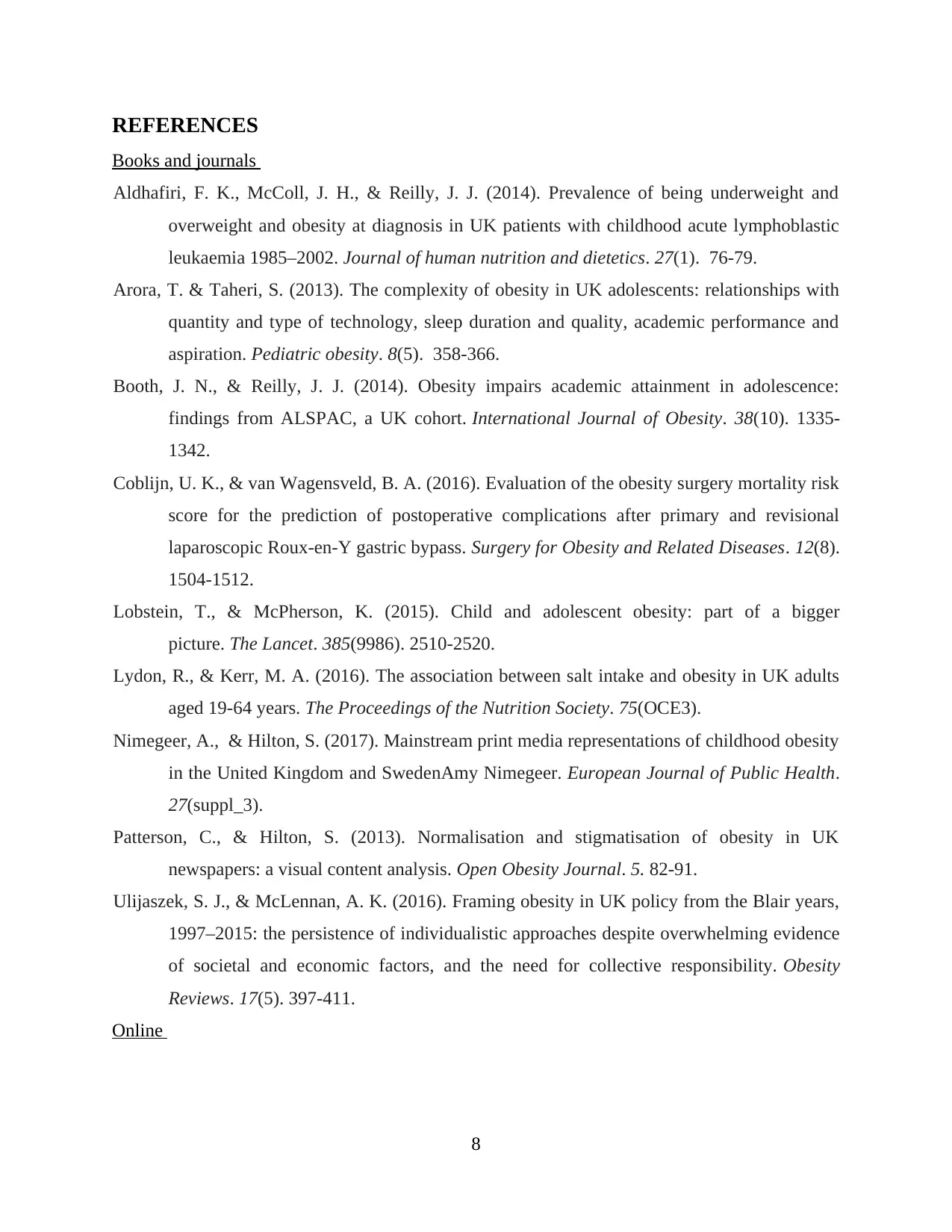
REFERENCES
Books and journals
Aldhafiri, F. K., McColl, J. H., & Reilly, J. J. (2014). Prevalence of being underweight and
overweight and obesity at diagnosis in UK patients with childhood acute lymphoblastic
leukaemia 1985–2002. Journal of human nutrition and dietetics. 27(1). 76-79.
Arora, T. & Taheri, S. (2013). The complexity of obesity in UK adolescents: relationships with
quantity and type of technology, sleep duration and quality, academic performance and
aspiration. Pediatric obesity. 8(5). 358-366.
Booth, J. N., & Reilly, J. J. (2014). Obesity impairs academic attainment in adolescence:
findings from ALSPAC, a UK cohort. International Journal of Obesity. 38(10). 1335-
1342.
Coblijn, U. K., & van Wagensveld, B. A. (2016). Evaluation of the obesity surgery mortality risk
score for the prediction of postoperative complications after primary and revisional
laparoscopic Roux-en-Y gastric bypass. Surgery for Obesity and Related Diseases. 12(8).
1504-1512.
Lobstein, T., & McPherson, K. (2015). Child and adolescent obesity: part of a bigger
picture. The Lancet. 385(9986). 2510-2520.
Lydon, R., & Kerr, M. A. (2016). The association between salt intake and obesity in UK adults
aged 19-64 years. The Proceedings of the Nutrition Society. 75(OCE3).
Nimegeer, A., & Hilton, S. (2017). Mainstream print media representations of childhood obesity
in the United Kingdom and SwedenAmy Nimegeer. European Journal of Public Health.
27(suppl_3).
Patterson, C., & Hilton, S. (2013). Normalisation and stigmatisation of obesity in UK
newspapers: a visual content analysis. Open Obesity Journal. 5. 82-91.
Ulijaszek, S. J., & McLennan, A. K. (2016). Framing obesity in UK policy from the Blair years,
1997–2015: the persistence of individualistic approaches despite overwhelming evidence
of societal and economic factors, and the need for collective responsibility. Obesity
Reviews. 17(5). 397-411.
Online
8
Books and journals
Aldhafiri, F. K., McColl, J. H., & Reilly, J. J. (2014). Prevalence of being underweight and
overweight and obesity at diagnosis in UK patients with childhood acute lymphoblastic
leukaemia 1985–2002. Journal of human nutrition and dietetics. 27(1). 76-79.
Arora, T. & Taheri, S. (2013). The complexity of obesity in UK adolescents: relationships with
quantity and type of technology, sleep duration and quality, academic performance and
aspiration. Pediatric obesity. 8(5). 358-366.
Booth, J. N., & Reilly, J. J. (2014). Obesity impairs academic attainment in adolescence:
findings from ALSPAC, a UK cohort. International Journal of Obesity. 38(10). 1335-
1342.
Coblijn, U. K., & van Wagensveld, B. A. (2016). Evaluation of the obesity surgery mortality risk
score for the prediction of postoperative complications after primary and revisional
laparoscopic Roux-en-Y gastric bypass. Surgery for Obesity and Related Diseases. 12(8).
1504-1512.
Lobstein, T., & McPherson, K. (2015). Child and adolescent obesity: part of a bigger
picture. The Lancet. 385(9986). 2510-2520.
Lydon, R., & Kerr, M. A. (2016). The association between salt intake and obesity in UK adults
aged 19-64 years. The Proceedings of the Nutrition Society. 75(OCE3).
Nimegeer, A., & Hilton, S. (2017). Mainstream print media representations of childhood obesity
in the United Kingdom and SwedenAmy Nimegeer. European Journal of Public Health.
27(suppl_3).
Patterson, C., & Hilton, S. (2013). Normalisation and stigmatisation of obesity in UK
newspapers: a visual content analysis. Open Obesity Journal. 5. 82-91.
Ulijaszek, S. J., & McLennan, A. K. (2016). Framing obesity in UK policy from the Blair years,
1997–2015: the persistence of individualistic approaches despite overwhelming evidence
of societal and economic factors, and the need for collective responsibility. Obesity
Reviews. 17(5). 397-411.
Online
8
Paraphrase This Document
Need a fresh take? Get an instant paraphrase of this document with our AI Paraphraser

.UK is most obese country in western Europe. 2017. [Online]
<https://www.theguardian.com/society/2017/nov/10/uk-most-obese-country-in-western-
europe-oecd-report-finds/>
Obesity and inequities. 2017. [PDF]
<http://www.euro.who.int/__data/assets/pdf_file/0003/247638/obesity-090514.pdf/>
9
<https://www.theguardian.com/society/2017/nov/10/uk-most-obese-country-in-western-
europe-oecd-report-finds/>
Obesity and inequities. 2017. [PDF]
<http://www.euro.who.int/__data/assets/pdf_file/0003/247638/obesity-090514.pdf/>
9
1 out of 11
Related Documents
Your All-in-One AI-Powered Toolkit for Academic Success.
+13062052269
info@desklib.com
Available 24*7 on WhatsApp / Email
![[object Object]](/_next/static/media/star-bottom.7253800d.svg)
Unlock your academic potential
Copyright © 2020–2025 A2Z Services. All Rights Reserved. Developed and managed by ZUCOL.





